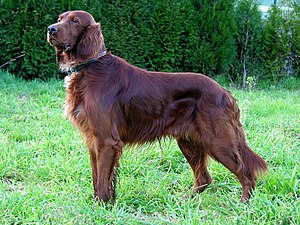Liver (color)
| Liver | ||
|---|---|---|
| (35, 19, 22°) | ||
| Source | ISCC-NBS | |
| ISCC–NBS descriptor | Grayish reddish brown | |
| B: Normalized to [0–255] (byte) | ||
At right is displayed the color traditionally called liver.
The first recorded use of liver as a color name in English was in 1686.[1]
Liver may also refer to a group of certain types of dark brown color in dogs and horses. Said nomenclature may also refer to the color of the organ.
In dogs

| Liver (Dogs) | ||
|---|---|---|
| (28, 33, 41°) | ||
| Source | [Unsourced] | |
| ISCC–NBS descriptor | Dark brown | |
| B: Normalized to [0–255] (byte) | ||
In dogs, the Liver color is caused by dilution of the
Liver dilution can also be combined with other genes that dilute a dog's coat. The D locus dilutes black pigment to a blue-grey color usually called Blue. It is a recessive trait like Liver. When a dog has both Liver and Blue dilution, it will appear to be a light, warm-gray color known as Isabella. This is the color of

There are many other dog colors that can look like brown, but are not Liver. A dog that is very dark red, like an
It is also possible for a dog to be a Liver, and not appear brown. A dog that is recessive red cannot produce
Liver chestnut in horses

| Liver Chestnut (horses) | ||
|---|---|---|
| (28, 16, 26°) | ||
| Source | [Unsourced] | |
| ISCC–NBS descriptor | Dark grayish brown | |
| B: Normalized to [0–255] (byte) | ||
In horses, liver chestnut is a chocolate-colored
The darkest liver chestnuts may be confused for black, but such horses are distinguished from other
Other dilution genes in horses analogous to those creating dilution shades in dogs do not create a liver color in horses. These include the dun gene, which produces a tan-colored or "blue"/gray solid colored coat and the champagne gene which tends to lighten the coat more than the mane or tail.
Liver (organ)

| Liver (organ) | ||
|---|---|---|
| (27, 47, 20°) | ||
| Source | [Unsourced] | |
| ISCC–NBS descriptor | Deep reddish brown | |
| B: Normalized to [0–255] (byte) | ||
This is the color of a healthy human
These healthy tones usually indicate blood flow, which is why livers and other meat turn grayish brown when cooked.[5]
Dark liver (web)
Liver (web) (#534B4F)
#534B4F
At right is displayed the color dark liver (web).
This is the shade of dark liver that is the unofficial web color called liver that is traditionally used in
In nature
- Liver-colored moray eel
- Liver-colored horses
See also
- List of colors
- Shades of brown
- Liver
- Chestnut (coat)
References
- ^ Maerz and Paul A Dictionary of Color New York: 1930 McGraw-Hill Page 198; Color Sample of Liver: Page 37 Plate 7 Color Sample H9.
- ^ Animal Genetics. "B-Locus (Brown, Liver, Chocolate)". www.horsetesting.com. Retrieved 2014-05-05. Use of copyrighted material rationale: no material was used, just referenced.
- PMID 12224446.
The statistical analysis of 1369 offspring from five stallions indicate, that darker shades of basic color phenotypes (dark chestnut, dark bay) follow a recessive mode of inheritance in the Franches-Montagnes horse breed.
- PMID 20955959.
- ^ Unknown, Various (Spring 2012). "Hepatic Pathology Index". Mercer School of Medicine Internet Pathology Laboratory for Medical Education. Retrieved 2013-01-21.Fair Use Rationale: this is an educational journal.


